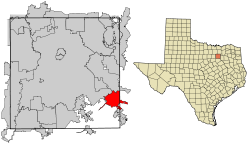Seagoville, Texas
USGenWeb >> TXGenWeb >> Dallas County >> Towns & Communities >> Seagoville, Texas
 |
|
| Latitude | 32° 39' 7" N 32.651944 |
| Longitude | 96° 33' 0" W -96.55 |
| Elevation feet/meters |
440/134 |
| Zip Code | 75159 |
| Founded | |
| GNIS FID | 1346844 |
| TXGenWeb Site | |
| Cemeteries | |
| Seagoville Public Library | |
| Local Genealogy Society | |
| Dallas ISD | |
| Crandall ISD | |
| Mesquite ISD | |
| Wikipedia | |
| seagoville.us | |
|
|||||||||||||||||||||||||||||||||
Seagoville
(/ˈsiːɡoʊvɪl/ SEE-goh-vil) was originally called Seago, and under this name was laid
out in 1876 by T. K. Seago (1836–1904), and named after him. The
United States Post Office changed the town's name to "Seagoville" in
1910 to prevent confusion with another city in Texas called Sego.
During World War II, the Federal Reformatory for Women in Seagoville
was the site of an Immigration and Naturalization Service detention
camp for Japanese, German and Italian Americans classified as "enemy
aliens" and women of Japanese and German ancestry deported from
Latin America. Internees at Seagoville published a German language
newsletter called the Sägedorfer Fliegende Blätter. The camp housed
up to 647 people, and was closed in June 1945, after the internees
were either "repatriated" to Japan or Germany, or transferred to
Crystal City, Texas.
.... Read More Wikipedia ....
Seagoville post office to close
The United States Postal Service operates the Seagoville Post Office on Seagoville Road in Kleberg, Dallas. It was previously located at 314 Glendale Avenue, in a rented facility in Seagoville. Since around 1882 a post office had been located in the Seagoville city limits. In 2011, the USPS announced that it was closing the existing Seagoville post office and consolidating it into the Kleberg Post Office, a USPS-owned facility since renamed to the Seagoville Post Office, citing cost-cutting reasons in response to a budget shortfall. Though individuals had offered to pay for the rental costs at Seagoville, the USPS insisted on closing the city post office. As of 2011, the Seagoville city post office was busier than the Kleberg one.
wfaa.com/Seagoville post office to close
Seagoville, a suburban residential community, is on State Highway 175 and the Southern Pacific line ten miles southeast of Mesquite in southeastern Dallas County. Interstate Highway 635, State Highway 75, and Interstate Highway 20 all skirt the community. Seagoville is on the original land grant of J. D. Merchant. One of the first recorded settlers in the area was Hugh L. Buchanan, who arrived in the 1860s. By 1867 John A. Brinegar had constructed a one-room log school with seats made of split logs. The early 1870s saw the arrival of the next group of settlers, which included the Cravens, Sorrells, Peaks, Moores, and Hawthornes, as well as the town's founder, T. K. Seago, who built a general store there in 1876. A community began to develop around the store, and in 1876 it was known as Seago. In that year B. F. Peak built a cotton gin, and two years later the community's first Baptist church was completed. Freight was shipped and received from locks on the Trinity River.
In 1880 Professor J. T. Doss constructed a new school, and in 1881 the Texas Trunk Railroad was completed through Seago; the area shipped cotton and alfalfa. The community secured a post office in 1881; this office was still open in the early 1990s. In 1885 the First Methodist Church was completed, and the community had a steam gristmill, a cotton gin, another general store, and a population of sixty, which included a teacher, a blacksmith, and a doctor. By 1890 Seago had a population of eighty-five, and another general merchandise store, established by J. L. Fly, supplied the area with farm implements. By 1902 Seago had a newspaper called The Star, which was edited by J. E. Laney. In 1908 the Trinity River flooded and caused considerable damage to the C. C. Cobb farm, one of the largest in the state. In 1910 the community's first brick school was constructed; it had ten grades and fifteen students. That year the post office name was changed to Seagoville to avoid confusion with the town of Sego. Two years later Seagoville drilled an artesian well. In 1914 A. H. McWhorter and M. P. Hawthorne built eight brick buildings, one of which housed a movie theater. By that time the community had a population of 300, five general stores, five grocery stores, two hardware stores, two restaurants, two drugstores, a lumberyard, a blacksmith shop, a cotton gin, and a printer. Seagoville also had a Western Union office, local telephone service, the Seagoville News, and the Farmers Guaranty State Bank.
.... Read More TSHA ....




